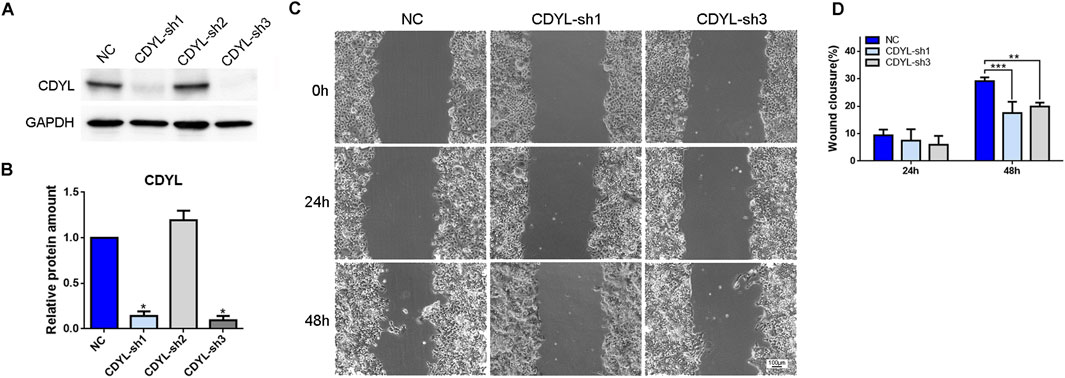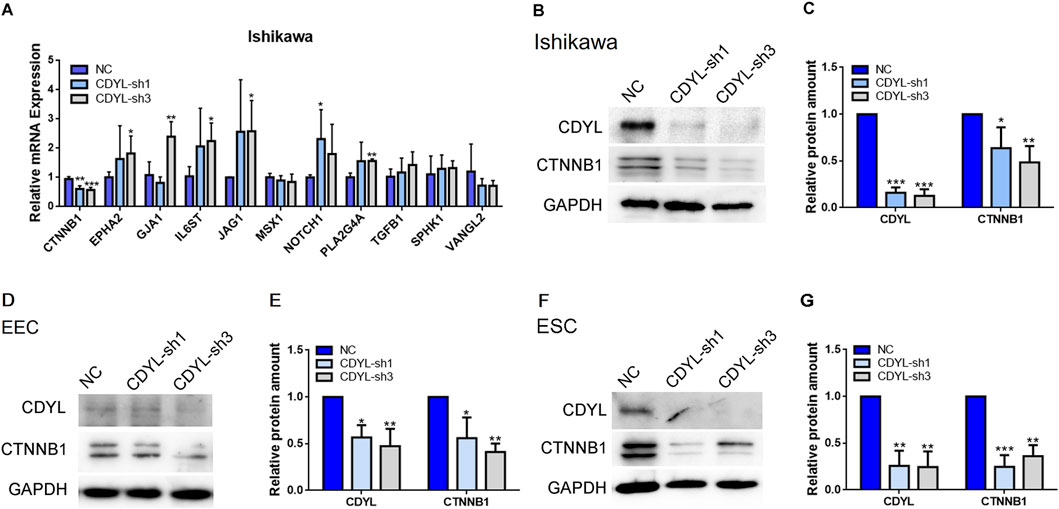- 1Department of Reproductive Medical Center, Ruijin Hospital, School of Medicine, Shanghai Jiao Tong University, Shanghai, China
- 2Department of Obstetrics and Gynecology, Chinese People’s Armed Police Force Shanghai Corps Hospital, Shanghai, China
- 3Department of Obstetrics and Gynaecology, BC Children’s Hospital Research Institute, The University of British Columbia, Vancouver, BC, Canada
- 4Department of Histoembryology, Genetics and Developmental Biology, School of Medicine, Shanghai Jiao Tong University, Shanghai, China
- 5Shanghai Key Laboratory of Reproductive Medicine, Shanghai Jiao Tong University, Shanghai, China
A Correction on
Loss of CDYL results in suppression of CTNNB1 and decreased endometrial receptivity
by Zhou X, Xu B, Zhang D, Jiang X, Chang H-M, Leung PCK, Xia X and Zhang A (2020). Front. Cell Dev. Biol. 8:105. doi: 10.3389/fcell.2020.00105
In the published article, there was an error in Figure 3C. The authors have identified that the image for the CDYL-sh1 48h treatment was inadvertently duplicated from the CDYL-sh3 24h treatment due to an error during figure preparation. The corrected Figure 3C and its caption appear below.

Figure 3. CDYL knockdown suppressed the cell migration capability in Ishikawa cells. The CDYL-knockdown efficiency was shown by Western blot analysis (A) and densitometric quantification (B). (C) Wound healing assay was used to examine the effect of CDYL silencing on cell migration. (D) The histograms show the quantitated percentage of wound closure. Bar = 100 µm. N = 3. All data are presented as mean ± SD. *P < 0.05; **P < 0.01; ***P < 0.001.
In the published article, there was an error in Figure 5F. Although the Western blot for CDYL in Figure 5F was performed on the same experimental day, it was not run on the same membrane as CTNNB1 and GAPDH, due to an error during figure preparation. The corrected Figure 5F and its caption appear below.

Figure 5. The decreased expression of CTNNB1 after CDYL knockdown in Ishikawa cells, EECs, and ESCs. (A) DEGs involved in the endometrial receptivity and implantation were validated by RT-qPCR. Protein expression levels of CDYL and CTNNB1 were decreased after CDYL silencing in Ishikawa cells (B,C), EECs (D,E), and ESCs (F,G) shown by Western blot and densitometric quantification. N ≥ 3. All data are presented as mean ± SD. *P < 0.05; **P < 0.01; ***P < 0.001.
The authors apologize for these errors and state that this does not change the scientific conclusions of the article in any way. The original article has been updated.
Publisher’s note
All claims expressed in this article are solely those of the authors and do not necessarily represent those of their affiliated organizations, or those of the publisher, the editors and the reviewers. Any product that may be evaluated in this article, or claim that may be made by its manufacturer, is not guaranteed or endorsed by the publisher.
Keywords: recurrent implantation failure, chromodomain Y like, catenin beta 1, migration, endometrial receptivity
Citation: Zhou X, Xu B, Zhang D, Jiang X, Chang H-M, Leung PCK, Xia X and Zhang A (2025) Correction: Loss of CDYL results in suppression of CTNNB1 and decreased endometrial receptivity. Front. Cell Dev. Biol. 13:1605628. doi: 10.3389/fcell.2025.1605628
Received: 03 April 2025; Accepted: 16 June 2025;
Published: 25 June 2025.
Edited and reviewed by:
Claudia Tanja Mierke, Leipzig University, GermanyCopyright © 2025 Zhou, Xu, Zhang, Jiang, Chang, Leung, Xia and Zhang. This is an open-access article distributed under the terms of the Creative Commons Attribution License (CC BY). The use, distribution or reproduction in other forums is permitted, provided the original author(s) and the copyright owner(s) are credited and that the original publication in this journal is cited, in accordance with accepted academic practice. No use, distribution or reproduction is permitted which does not comply with these terms.
*Correspondence: Xiaoyu Xia, enB4aWF4eUBzaHNtdS5lZHUuY24=; Aijun Zhang, emhhajEyNjhAMTYzLmNvbQ==
†These authors have contributed equally to this work
 Xiaowei Zhou
Xiaowei Zhou Bufang Xu
Bufang Xu Dan Zhang
Dan Zhang Xiaoping Jiang2
Xiaoping Jiang2 Hsun-Ming Chang
Hsun-Ming Chang Peter C. K. Leung
Peter C. K. Leung Xiaoyu Xia
Xiaoyu Xia Aijun Zhang
Aijun Zhang